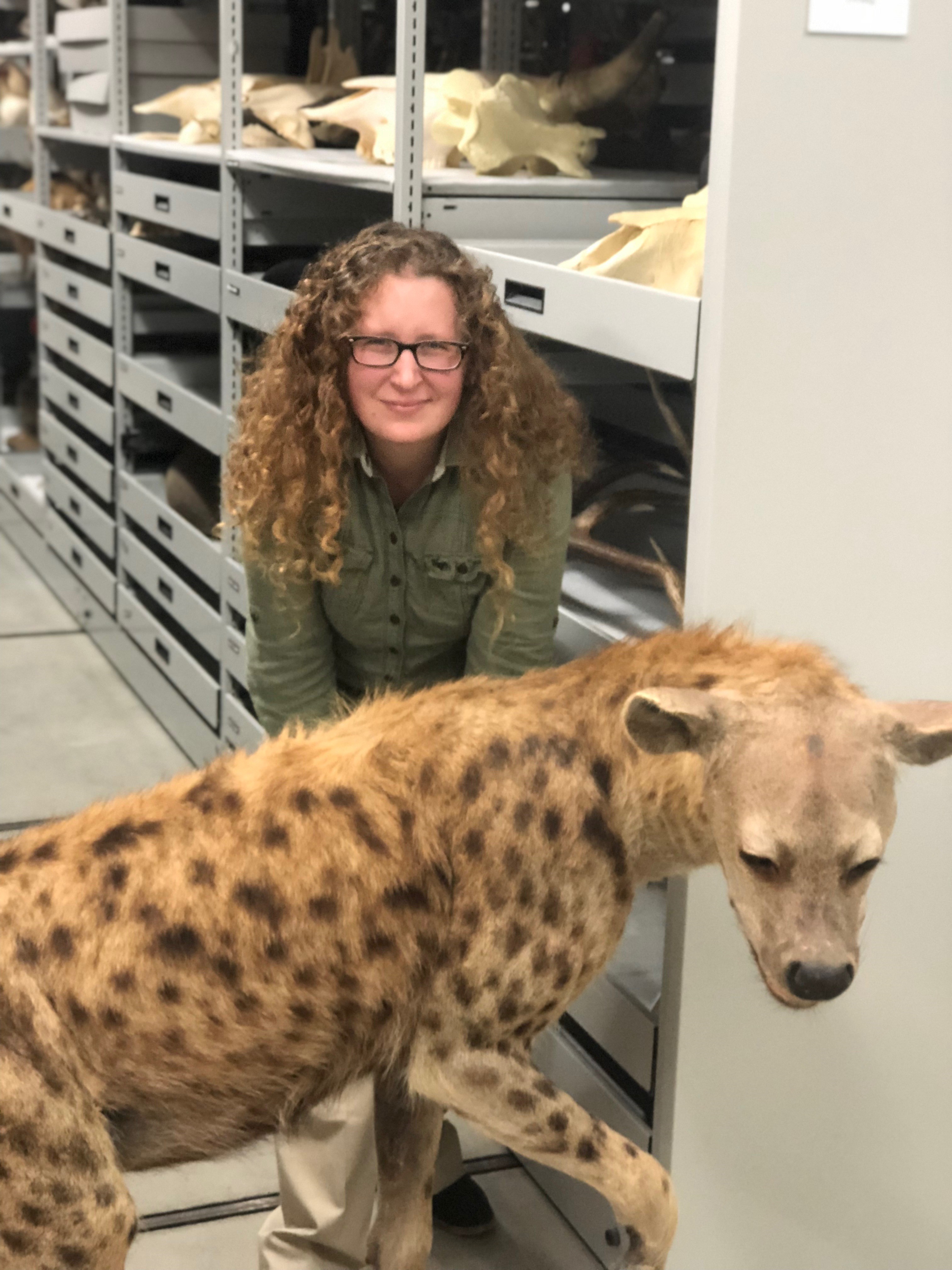 Lead author Jennifer Anné with a spotted hyaena mount
Lead author Jennifer Anné with a spotted hyaena mount
Until recently, it was thought that warm-blooded animals experienced uninterrupted high rates of growth, whilst cold-blooded animals showed zonal growth - alternating periods of fast and slow growth. The identification of zonal growth in a range of mammals and birds disproved that theory, but as yet we don’t know how widespread zonal growth is in vertebrates, or which factors affect the speed of bone growth. Conventional techniques lack the resolution to correlate variations in bone chemistry with histological features, but in work recently published in the Journal of Analytical Atomic Spectrometry, an international team of researchers carried out the first direct comparison between optical histology (bone tissue identification) and synchrotron-based chemical mapping, quantification, and characterisation of trace elements (biochemistry) within cyclic growth tissues, and reported the first case of zonal tissue within the Hyaenidae.

The life history and physiology of vertebrates is recorded in their bones, and skeletal remains can provide key information on the metabolism and biological cycles of extinct animals. The trace element content of bones is known to correlate with specific histological structures, and by studying trace elements in fossilised bone, we can improve our understanding of the physiology of extinct organisms.
This is particularly true for species that show cyclic bone growth (alternating fast/slow bone deposition), which is recognised in histological sections as alternating bands, known as zonal tissue.

Previous studies have shown that the key trace elements for bone physiology (most notably copper, zinc and strontium) can be mapped within discrete histological features, which correlate to specific physiological processes such as active bone growth and remodelling. Comparing differences in chemical inventories between fast (zones) and slow (annuli) depositional tissues can provide information on the physiological processes that control the switch between the two growth rates.
Commonly available techniques are unable to resolve the discrete variations (ppm levels) in chemistry at the necessary resolution (micron) and scale (decimetre) to carry out such a study, but recent work using synchrotron-based X-ray fluorescence (XRF) has demonstrated its ability to resolve the chemical variations associated within fine scale histological features in both modern and fossil bones.
For this study, a team of researchers from the UK and the USA carried out the first histological and trace element analyses of bones from extinct cave hyaena (Crocuta crocuta spelaea) and their closest living relative, the spotted hyaena (Crocuta crocuta). Their aim was to determine whether they could correlate cyclic growth with the distributions of trace elements crucial for bone growth, and whether those elements are preserved in fossilised tissues.

The results show distributions of zinc, an element strongly associated with bone growth, correlating with fast-growing tissue of zonal bone (cyclic growth) in a cave hyaena, and remodelling in both the spotted and cave hyaena. The concentrations and chemistry of zinc are similar in the fossil samples and the more modern bones, suggesting that the chemistry of bone growth has been preserved for 40,000 years, and demonstrating that the study of trace elements as part of the histochemistry has wide utility for reconstructing growth, diet and other lifestyle factors in archaeological and fossil bone.
This study reports the first case of zonal tissue within the Hyaenidae, both extant and fossil. Not all fossil bones displayed zonal tissue, and this could be due to intraskeletal variation, as different bones were analysed. However, it is interesting to note that the fossil hyaena displaying cyclic growth is from a colder phase of the last ice age, whereas the specimens without annular zones are from a warmer phase. Further work is needed to test the hypothesis that extreme seasonal differences may have caused the differences observed between individual hyaena.
Anné J et al. Morphological and chemical evidence for cyclic bone growth in a fossil hyaena. Journal of Analytical Atomic Spectrometry 33.12, 2062-2069 (2018). DOI:10.1039/c8ja00314a.
Diamond Light Source is the UK's national synchrotron science facility, located at the Harwell Science and Innovation Campus in Oxfordshire.
Copyright © 2022 Diamond Light Source
Diamond Light Source Ltd
Diamond House
Harwell Science & Innovation Campus
Didcot
Oxfordshire
OX11 0DE
Diamond Light Source® and the Diamond logo are registered trademarks of Diamond Light Source Ltd
Registered in England and Wales at Diamond House, Harwell Science and Innovation Campus, Didcot, Oxfordshire, OX11 0DE, United Kingdom. Company number: 4375679. VAT number: 287 461 957. Economic Operators Registration and Identification (EORI) number: GB287461957003.